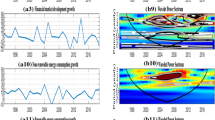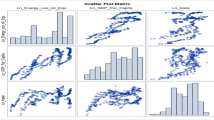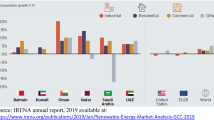Abstract
Energy is one of the prime factors in influencing the sustainable development of a country. Different energy sources play important roles in driving the income growth of different economic sectors such as industrial, agricultural, and services. Fossil fuels, however, have come under strong criticism for actively accelerating climate change. As such, it is imperative to investigate the contributions of various energy sources toward sustainable growth. With Malaysia as the test-bed, the present study analyzes the impact of energy prices on economic stability using the novel wavelet-based analysis. Specifically, the study analyzed the impact of crude oil, natural gas, and gasoline prices on the economic (brown) and green growth from 1995 to 2020. The results show that in continuous wavelet transform, the cone of influence of all five factors exhibits strong short-run variance and fluctuations from 2005 to 2013. However, the intensity of brown growth is more influential than green growth. Similarly, in wavelet coherence graphs, the downward right arrows indicate positively significant associations between crude oil prices, natural gas prices, and gasoline prices with brown and green growth. Additionally, wavelet-based Granger causality reveals a bidirectional causal relationship between all variables. The results thus strongly suggest that energy prices predominantly affect the economic (brown) and green growth progression of the Malaysian economy. The study concludes with some suggested implications to augment the country’s sustainable growth.











Similar content being viewed by others
Data availability
The data that support the findings of this study are openly available on request.
References
Abid M (2020) The long-run and short-run effects of oil price on energy consumption in Tunisia: evidence from structural breaks analysis. Energy Sources B: Econ Plan Policy 15(4):252–277
Adam P, Rahim M, Rosnawintang R (2019) The effect of crude oil prices on economic growth in South East Sulawesi, Indonesia: an application of autoregressive distributed lag model. Int J Energy Econ Policy 9(2):194
Afshan S, Ozturk I, Yaqoob T (2022) Facilitating renewable energy transition, ecological innovations and stringent environmental policies to improve ecological sustainability: evidence from MM-QR method. Renew Energy 196:151–160
Assi AF, Isiksal A, Tursoy T (2020) The asymmetric association between the consumption of gasoline, financial advancement, and economic freedom in Singapore. In: In 2020 International conference on decision aid sciences and application (DASA). IEEE, pp 1269–1273
Anser MK, Yousaf Z, Khan MA, Nassani AA, Alotaibi SM, Abro MMQ et al (2020) Does communicable diseases (including COVID-19) may increase global poverty risk? A cloud on the horizon. Environ Res 187:109668
Atil A, Lahiani A, Nguyen DK (2014) Asymmetric and nonlinear pass-through of crude oil prices to gasoline and natural gas prices. Energy Policy 65:567–573
Atil A, Nawaz K, Lahiani A, Roubaud D (2020) Are natural resources a blessing or a curse for financial development in Pakistan? The importance of oil prices, economic growth and economic globalization. Resour Policy 67:101683
Awan AM, Azam M (2022) Evaluating the impact of GDP per capita on environmental degradation for G-20 economies: does N-shaped environmental Kuznets curve exist? Environ Dev Sustain 24(9):11103–11126
Balcilar M, Usman O, Ike GN (2023) Investing green for sustainable development without ditching economic growth. Sustain Dev 31(2):728–743
Bank Negara Malaysia (2022). Economic and Monetary Review Report. Retrived from https://www.bnm.gov.my/-/ar2022_en_pr
Chen Y, Kumara EK, Sivakumar V (2021) Investigation of finance industry on risk awareness model and digital economic growth. Ann Oper Res 1–22
Cheng KK, Lam TH, Leung CC (2022) Wearing face masks in the community during the COVID-19 pandemic: altruism and solidarity. The Lancet 399(10336):39–40
Cheong CWH (2022) Political regimes and its influence on the diversity–performance relationship in Malaysia. Asia-Pac J Bus Admin. https://doi.org/10.1108/APJBA-07-2021-0321
Chien F, Ajaz T, Andlib Z, Chau KY, Ahmad P, Sharif A (2021) The role of technology innovation, renewable energy and globalization in reducing environmental degradation in Pakistan: a step towards sustainable environment. Renew Energy 177:308–317
Corbett JJ, Winebrake JJ (2018) Environmental issues in international trade and transportation. In: Handbook of International Trade and Transportation. Edward Elgar Publishing, pp 275–296
Ekananda M (2022) Role of macroeconomic determinants on the natural resource commodity prices: Indonesia futures volatility. Resour Policy 78:102815
Etokakpan MU, Solarin SA, Yorucu V, Bekun FV, Sarkodie SA (2020) Modeling natural gas consumption, capital formation, globalization, CO2 emissions and economic growth nexus in Malaysia: fresh evidence from combined cointegration and causality analysis. Energy Strategy Rev 31:100526
Fan Y, Gençay R (2010) Unit root tests with wavelets. Econom Theory 26(5):1305–1331
Fay M (2012) Inclusive green growth: the pathway to sustainable development. World Bank Publications
Folkers A (2021) Fossil modernity: the materiality of acceleration, slow violence, and ecological futures. Time Soc 30(2):223–246
Ghazouani T (2021) Impact of FDI inflow, crude oil prices, and economic growth on CO2 emission in Tunisia: symmetric and asymmetric analysis through ARDL and NARDL approach. Environ Econ 12(1):1
Godil DI, Sarwat S, Khan MK, Ashraf MS, Sharif A, Ozturk I (2022) How the price dynamics of energy resources and precious metals interact with conventional and Islamic Stocks: fresh insight from dynamic ARDL approach. Resour Policy 75:102470
Grinsted A, Moore JC, Jevrejeva S (2004) Application of the cross wavelet transform and wavelet coherence to geophysical time series. Nonlinear Process Geophys 11(5/6):561-566
Guan L, Zhang WW, Ahmad F, Naqvi B (2021) The volatility of natural resource prices and its impact on the economic growth for natural resource-dependent economies: a comparison of oil and gold dependent economies. Resour Policy 72:102125
Ha YH, Byrne J (2019) The rise and fall of green growth: Korea’s energy sector experiment and its lessons for sustainable energy policy. Wiley Interdiscip Rev.: Energy Environ 8(4):e335
Huber J (2020) Ecological modernization: beyond scarcity and bureaucracy. In: The Ecological Modernisation Reader. Routledge, pp 42–55
Hussain J, Zhou K (2022) Globalization, industrialization, and urbanization in Belt and Road Initiative countries: implications for environmental sustainability and energy demand. Environ Sci Pollut Res 29(53):80549–80567
Ike GN, Usman O, Alola AA, Sarkodie SA (2020) Environmental quality effects of income, energy prices and trade: the role of renewable energy consumption in G-7 countries. Sci Total Environ 721:137813
Irfan M, Razzaq A, Sharif A, Yang X (2022) Influence mechanism between green finance and green innovation: exploring regional policy intervention effects in China. Technol Forecast Soc Change 182:121882
Kriskkumar K, Naseem NAM, Azman-Saini WNW (2022) Investigating the asymmetric effect of oil price on the economic growth in malaysia: applying augmented ARDL and nonlinear ARDL techniques. SAGE Open 12(1):21582440221079936
Kuang Y, Lin B (2022) Natural gas resource utilization, environmental policy and green economic development: Empirical evidence from China. Resour Policy 79:102992
Lai FW, Shad MK, Shah SQA (2021) Conceptualizing corporate sustainability reporting and risk management towards green growth in the Malaysian oil and gas industry. In: SHS Web of Conferences, vol 124. EDP Sciences, p 04001
Li J, Dong X, Dong K (2022) Is China’s green growth possible? The roles of green trade and green energy. Econ Res-Ekon Istraz 35(1):7084–7108
Liddle B, Sadorsky P (2020) How much do asymmetric changes in income and energy prices affect energy demand? J Econ Asymmetries 21:e00141
Majid MA (2020) Renewable energy for sustainable development in India: current status, future prospects, challenges, employment, and investment opportunities. Energy Sustain Soc 10(1):1–36
Miamo CW, Achuo ED (2022) Can the resource curse be avoided? An empirical examination of the nexus between crude oil price and economic growth. SN Bus Econ 2(1):1–23
Mohamued EA, Ahmed M, Pypłacz P, Liczmańska-Kopcewicz K, Khan MA (2021) Global oil price and innovation for sustainability: the impact of R&D spending, oil price and oil price volatility on GHG emissions. Energies 14(6):1757
Moradi MA, Salimi M, Amidpour M (2021) Cost-benefit analysis of gasoline demand control policies and its greenhouse gas mitigation co-benefits. Energy 233:121173
Mujtaba A, Jena PK (2021) Analyzing asymmetric impact of economic growth, energy use, FDI inflows, and oil prices on CO2 emissions through NARDL approach. Environ Sci Pollut Res 28(24):30873–30886
Odhiambo N (2020) Oil price and economic growth of oil-importing countries: a review of international literature. Appl Econ Int Dev 20:1–23
Odugbesan JA, Ike G, Olowu G, Adeleye BN (2022) Investigating the causality between financial inclusion, financial development and sustainable development in Sub-Saharan Africa economies: the mediating role of foreign direct investment. J Public Aff 22(3):e2569
Ofori IK, Gbolonyo EY, Ojong N (2022) Towards Inclusive Green Growth in Africa: critical energy efficiency synergies and governance thresholds. J Clean Prod 369:132917
Ou S, Lin Z, Xu G, Hao X, Li H, Gao Z, He X, Przesmitzki S, Bouchard J (2020) The retailed gasoline price in China: time-series analysis and future trend projection. Energy 191:116544
Prabheesh KP, Kumar S (2021) The dynamics of oil prices, exchange rates, and the stock market under COVID-19 uncertainty: evidence from India. Energy Res Lett 2(3):1–8
Rizvi SKA, Naqvi B, Boubaker S, Mirza N (2022) Energy Econ 112:106131
Sadik-Zada ER, Gatto A (2021) Energy security pathways in South East Europe: diversification of the natural gas supplies, energy transition, and energy futures. In: From Economic to Energy Transition. Palgrave Macmillan, Cham, pp 491–514
Safaei N, Zhou C, Safaei B, Masoud A (2021) Gasoline prices and their relationship to the number of fatal crashes on US roads. Transp Eng 4:100053
Shahzad SJH, Shahbaz M, Ferrer R, Kumar RR (2017) Tourism-led growth hypothesis in the top ten tourist destinations: new evidence using the quantile-on-quantile approach. Tour Manag 60:223–232
Shangle A, Solaymani S (2020) Responses of monetary policies to oil price changes in Malaysia. Energy 200:117553
Sharif A, Saha S, Campbell N, Sinha A, Ibrahiem DM (2020) Tourism, environment and energy: an analysis for China. Curr Issues Tour 23(23):2930–2949
Shittu W, Adedoyin FF, Shah MI, Musibau HO (2021) An investigation of the nexus between natural resources, environmental performance, energy security and environmental degradation: evidence from Asia. Resour Policy 73:102227
Su CW, Huang SW, Qin M, Umar M (2021) Does crude oil price stimulate economic policy uncertainty in BRICS? Pacific-Basin Finance J 66:101519
Taghizadeh-Hesary F, Yoshino N, Mohammadi Hossein Abadi M, Farboudmanesh R (2016) Response of macro variables of emerging and developed oil importers to oil price movements. J Asian Pac Econ 21(1):91–102
Talha M, Sohail M, Tariq R, Ahmad MT (2021) Impact of oil prices, energy consumption and economic growth on the inflation rate in Malaysia. Cuadernos de Economía 44(124):26–32
Tang CS, Kogid M, Alin J, Dollery B (2022) Modelling sectoral energy consumption in malaysia: assessing the asymmetric effects. Sustainability 14(3):1816
Tawiah V, Zakari A, Adedoyin FF (2021) Determinants of green growth in developed and developing countries. Environ Sci Pollut Res 28(29):39227–39242
Tiwari AK, Abakah EJA, Le TL, Leyva-de la Hiz DI (2021) Markov-switching dependence between artificial intelligence and carbon price: the role of policy uncertainty in the era of the 4th industrial revolution and the effect of COVID-19 pandemic. Technol Forecast Soc Change 163:120434
Torrence C, Compo GP (1998) A practical guide to wavelet analysis. Bull Am Meteorol Soc 79(1):61–78
Torrence C, Webster PJ (1999) Interdecadal changes in the ENSO-monsoon system. J Clim 12(8):2679–2690
Usman, O., Alola, A. A., & Ike, G. N. 2021 Modelling the effect of energy consumption on different environmental indicators in the United States: the role of financial development and renewable energy innovations. In Natural resources forum (45, 4, 441-463). Oxford, UK: Blackwell Publishing Ltd.
Wang G, Sharma P, Jain V, Shukla A, Shabbir MS, Tabash MI, Chawla C (2022) The relationship among oil prices volatility, inflation rate, and sustainable economic growth: evidence from top oil importer and exporter countries. Resour Policy 77:102674
Wei H, Rizvi SKA, Ahmad F, Zhang Y (2020) Resource cursed or resource blessed? The role of investment and energy prices in G7 countries. Resour Policy 67:101663
Wei P, Li Y, Ren X, Duan K (2022) Crude oil price uncertainty and corporate carbon emissions. Environ Sci Pollut Res 29(2):2385–2400
Wong SL, Chia WM, Chang Y (2013) Energy consumption and energy R&D in OECD: perspectives from oil prices and economic growth. Energy Policy 62:1581–1590
Yang J, Rizvi SKA, Tan Z, Umar M, Koondhar MA (2021) The competing role of natural gas and oil as fossil fuel and the nonlinear dynamics of resource curse in Russia. Resour Policy 72:102100
Young SC (2018) Introduction: the origins and evolving nature of ecological modernisation. In: The emergence of ecological modernisation. Routledge, pp 1–39
Zafar MW, Shahbaz M, Hou F, Sinha A (2019) From nonrenewable to renewable energy and its impact on economic growth: the role of research & development expenditures in Asia-Pacific Economic Cooperation countries. J Clean Prod 212:1166–1178
Zeng A, Ho H, Yu Y (2020) Prediction of building electricity usage using Gaussian Process Regression. J Build Eng 28:101054
Zhang YJ, Li SH (2019) The impact of investor sentiment on crude oil market risks: evidence from the wavelet approach. Quant Finance 19(8):1357–1371
Funding
This paper was supported by the Fundamental Research Grant Scheme (FRGS) Project: FRGS/1/2020/SS01/SYUC/03/2, provided by the Ministry of Higher Education, Malaysia.
Author information
Authors and Affiliations
Contributions
Sahar Afshan: conceptualization, writing—original draft, data curation. Calvin W.H. Cheong: review and editing, writing—original draft. Arshian Sharif: writing—original draft, formal analysis.
Corresponding author
Ethics declarations
Ethical approval and consent to participate
N/A.
Consent for publication
We do not have any individual person’s data in any form.
Competing interests
The authors declare no competing interests.
Additional information
Responsible Editor: Roula Inglesi-Lotz
Publisher’s note
Springer Nature remains neutral with regard to jurisdictional claims in published maps and institutional affiliations.
Rights and permissions
Springer Nature or its licensor (e.g. a society or other partner) holds exclusive rights to this article under a publishing agreement with the author(s) or other rightsholder(s); author self-archiving of the accepted manuscript version of this article is solely governed by the terms of such publishing agreement and applicable law.
About this article
Cite this article
Afshan, ., Cheong, C.W.H. & Sharif, A. Modelling the role of energy price movements toward economic stability in Malaysia: new evidence from wavelet-based analysis. Environ Sci Pollut Res 30, 88861–88875 (2023). https://doi.org/10.1007/s11356-023-28660-0
Received:
Accepted:
Published:
Issue Date:
DOI: https://doi.org/10.1007/s11356-023-28660-0




